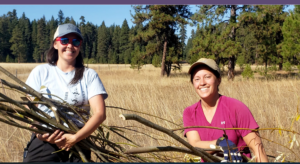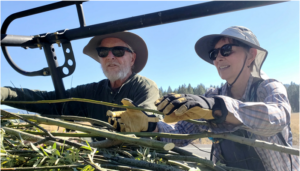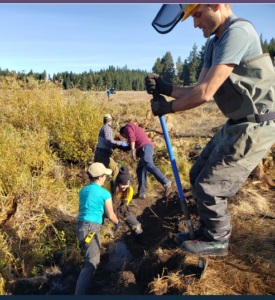This was a fine way to end the holiday weekend. The beavers won the civil war and a fantastic article appeared in Jefferson radio about restoring Vesper meadow near Ashland in the hopes of beavers returning to it.
Bringing back the beavers
For four years, Jeanine Moy has led programming to restore, monitor and explore Vesper Meadow, near Ashland. One of her prime objectives has been to restore Latgawa Creek and set the table for the beaver’s return.
 In 2018, Moy was serving as outreach director for the nonprofit Klamath-Siskiyou Wildlands Center, but she wanted to create a program or organization of her own that reflected her holistic vision of conservation—one that elevated art along with science, educated people while building community, and restored cultures as well as ecosystems.
In 2018, Moy was serving as outreach director for the nonprofit Klamath-Siskiyou Wildlands Center, but she wanted to create a program or organization of her own that reflected her holistic vision of conservation—one that elevated art along with science, educated people while building community, and restored cultures as well as ecosystems.
She met Ross while teaching a class for older adults at Southern Oregon University. Ross recalls how Moy described that healthy landscapes can act like sponges, slowing and soaking up water.
“That really spoke to me,” says Ross. “Water is so scarce now.”
Ross and Conaway were comfortably retired, and with money in the bank from a house sale in California, they wanted to give back. “We were looking at what we could do with climate change and community building that would be gratifying and open up opportunities for a lot of people,” says Ross, who is nearly 70. She and Moy decided to partner on a project: Ross would acquire a parcel of land ripe for restoration; Moy would live onsite, develop programming and raise funds.
decided to partner on a project: Ross would acquire a parcel of land ripe for restoration; Moy would live onsite, develop programming and raise funds.
That year, Ross and Conaway purchased 323 acres and worked with the Southern Oregon Land Conservancy to place all but seven in a conservation easement. They named it Vesper Meadow, after the vesper sparrow, a grassland bird discovered there during surveys.
Now that’s the way to do it. Retire and sell your home in California and move to Oregon to bring back beavers. Way to go team!
If you glimpse Vesper Meadow from the highway, you’ll likely see a lovely expanse of open space that’s dotted with wildflowers in early summer and blanketed in snow in winter. It’s hard to spot the degradation unless you know what you’re looking for.
Thanks in large part to beavers, Vesper Meadow was once a complex, wet meadow, says Sarah Koenigsberg, communications director for The Beaver Coalition, a nonprofit focused on promoting beavers as agents of conservation. “The water table was right near the surface, and there were lots of teeny tiny channels and rivulets and wet swampy areas,” she explains. Conifers, which don’t like “wet feet,” grew further upslope, but aspen, willows, and camas thrived in the meadow. Several groups of indigenous people, including Shasta, Latgawa, and Takelma, likely harvested camas and other foods, gathered seeds, and managed the land with fire.
To slow the erosion along Latgawa Creek, Moy and an army of volunteers immediately started planting willows. Willow planting is a time-honored restoration strategy, and you don’t need a permit to plant them.
But Moy wanted to do more.
“The waterway being so degraded and showcased with the highway running through it lends itself to being a restoration demonstration site,” she explains.
Moy quickly honed in on bringing beavers back to Vesper Meadow. Not only do beaver-managed landscapes support a variety of plants, animals, and pollinators, they also help buffer the land during droughts and can even slow down or stop a wildfire.
But you can’t just drop a bunch of beavers off in a dry meadow, says Koenigsberg. “There’s no food. They’d starve, or get eaten by predators.” First, you have to set the table.
As long as the highway is bringing people closer, you might as well educate them. Right?
 After talking with experts from The Beaver Coalition and NOAA, Moy decided to use a low-tech strategy called process-based restoration. It doesn’t require heavy equipment or engineering degrees, just lots of human hands. She started planning the log structures in the summer of 2020.
After talking with experts from The Beaver Coalition and NOAA, Moy decided to use a low-tech strategy called process-based restoration. It doesn’t require heavy equipment or engineering degrees, just lots of human hands. She started planning the log structures in the summer of 2020.
Sheri Hagwood, Partners for Fish and Wildlife botanist with the US Fish and Wildlife Service, suggested Moy apply for funding and technical assistance through the Partners for Fish and Wildlife program, which helps private landowners enhance their properties for wildlife.
Vesper Meadow received $36,000 through the Partners program (and matched it with over $37,000). Hagwood helped Moy with planning and permitting. To build the structures, she needed to obtain a host of permits from federal, state, and county agencies, which evaluate everything from water quality to the project’s impact on cultural resources.
Moy bumped into the FEMA requirement when applying to Jackson County for a floodplain development permit. Part of the meadow was a FEMA mapped flood zone. An engineering analysis showed that during a hypothetical “100-year” flood, her project would raise the water level in one part of this zone by 8 inches, which the county didn’t allow.
According to Moy, the flood map didn’t match what was actually on the ground. Her only course of action was to apply to FEMA to revise the map and show that no homes or other buildings would be threatened by her project.
“The whole FEMA process is in place to protect homeowners from flooding, but there are no other homes anywhere near this floodplain,” says Moy. “It just seemed excessive for us to be able to put some sticks in the creek.”
She used part of her budget to hire an engineer to map and analyze the creek. Finally, last November, they mailed the application to FEMA.
After a few months, she followed up. FEMA had never received her materials. She sent them again. For the next several months, the FEMA representative and her engineer went back and forth with requests and revisions. With the weather window for building the log structures closing, Moy planned Beaver Days.
First you build it and then get out of the way and then they will come. Let them be in charge of the process from there.
It’s humbling to admit that a rodent can do this work better than we can, says Koenigsburg. “This kind of restoration challenges human nature,” she adds. “We like control and we don’t like messy. But we’re at this turning point: Do we want control, or do we want water, biodiversity, and firebreaks?”
Moy’s plan is not to hand the meadow off to beavers and leave. A key part of her programming is to restore human presence to Vesper Meadow, using art, education, science, and hands-on work to draw people in. Vesper Meadow helped cofound the Indigenous Gardens Network and has invited Siletz and Grande Ronde tribal members to re-connect with a landscape their ancestors knew intimately.
“More and more I use the term bio-cultural restoration,” says Moy. “It’s not just humans visiting and restoring and measuring [Vesper Meadow] but rather building personal relationships with the land and tending it over time.”
And scene. Vesper meadows is in good hands because of the beavers work and your vision. Well done. Thanks to the beaver coalition for helping out.


 In 2019, a small group of biologists trekked to a shallow pond in the Cascade-Siskiyou National Monument carrying heavy burlap bags. Jacob Shockey, executive director of the Beaver Coalition, set his bag on the ground, and out popped a beaver. Docile, soft brown, and surprisingly large, it waddled toward an opening in the reeds and slid into the water, suddenly graceful. The group watched hopefully as the beavers, all rescued from the same suburban field in Medford, explored their new home.
In 2019, a small group of biologists trekked to a shallow pond in the Cascade-Siskiyou National Monument carrying heavy burlap bags. Jacob Shockey, executive director of the Beaver Coalition, set his bag on the ground, and out popped a beaver. Docile, soft brown, and surprisingly large, it waddled toward an opening in the reeds and slid into the water, suddenly graceful. The group watched hopefully as the beavers, all rescued from the same suburban field in Medford, explored their new home.



































